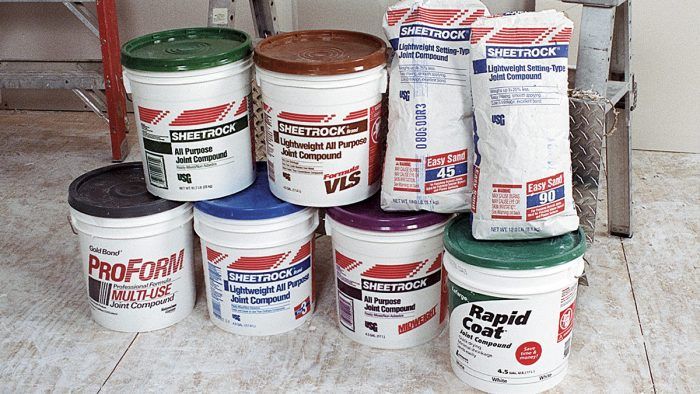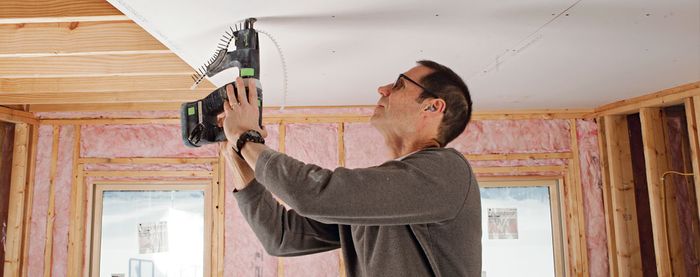
There are so many types and brands of joint compound that it can be difficult to know which ones to use. The most important distinction is between drying-type compounds and setting-type compounds. Here, I’ll describe some of the most popular types within each of these categories.
Drying-type joint compound Drying-type joint compound is the type most commonly used. Available in both premixed and dry (powdered) forms, drying-type joint compound makes up the bulk of what you see in buckets and boxes at your local hardware store.
Most drying-type compounds are vinyl-based and dry as the water evaporates. They require an application temperature of at least 55°F (this includes air, surface, and compound temperatures). The compound must dry thoroughly between coats, and the drying time is greatly affected by temperature, humidity, and airflow. (Under good conditions, drying-type compounds dry within 24 hours.)
Premixed drying-type joint compound comes in 1-gal. and 5-gal. buckets and boxes. The 1-gal. size is good for patching small jobs; the 5-gal. bucket is enough to tape an average 12-ft. by 12-ft. room.
Using the premixed compounds offers a few advantages:
- It is ready to use right out of the bucket.
- The consistency of the mix is factory controlled, and most brands are equal in quality.
- There is little waste with premixed compound—the bucket can be resealed and used again later.
There are a few cautions to remember when using premixed compounds. First, the fresher the better. To preserve freshness, keep buckets out of direct sunlight and don’t allow the compound to freeze. Also remember, premixed compound will not keep indefinitely—especially after it has been opened; at room temperature, a previously open bucket of compound will start to go bad in about a month.
| Choosing the Right Joint Compound
When deciding which type of joint compound to use, consider the following factors:
|
| WORK SMART: Be aware that the setting time of joint compound can be adversely affected by overmixing or undermixing, mixing a compound that has been in the sun or cold, and using dirty water (and equipment) or water that is too warm or cold. |
Powdered drying-type joint compound has all the same working characteristics as the premixed compound. The major difference is that it comes in dry form and must be mixed with water. A compound in dry form can be stored and transported at any temperature (though it should always be brought to room temperature before mixing). Once mixed the compound is treated and stored just like the premixed compound.
| WORK SMART: Regardless of the type of compound you use on the first two coats, use a drying-type compound for the final coat—it’s easier to work with and sand. |
I use three kinds of drying-type joint compound on a regular basis (each is available premixed or dry):
- Taping compound is used to embed the joint tape for the first coat and as filler for the second coat. It is a strong compound, has little shrinkage as it dries, and has excellent bonding and resistance to cracking.
- Topping compound is used for a thin finishing coat. It is easy to work with, feathers out nicely, dries quickly, and sands smooth. Topping compound can be used over taping compound or over all-purpose joint compound.
- All-purpose compound can be used for all stages of the taping process—to embed the tape—as a filler coat—and as a finish coat. Because it’s more convenient to deal with just one type, all-purpose compound is the most commonly used compound. However, it doesn’t have the same strength, bonding qualities, or stability as the taping and topping combination.
| Approximate Coverage of Materials
Screws and Nails Joint Tape Joint Compound
|
Setting-type joint compounds Whereas drying-type compounds are vinyl-based and dry as the water evaporates, setting-type compounds harden by chemical reaction. The great advantage of setting-type compounds, which are only available in powdered form, is that they harden faster than drying-type compounds. Unlike drying-type compounds, setting-type compounds actually harden before the joint is completely dry. When first mixed, setting compound is smooth and as easy to use as drying compound.
Setting times vary from 20 minutes to 6 hours, depending on the type used. I prefer a product that sets in 3 to 4 hours, which gives me enough time to apply the compound to the seams. I know that it will be ready for another coat of compound by the next day, even in humid or cool conditions (air, surface, and compound temperatures can be as low as 45°F). Furthermore, setting compound can be given a second and third coat as soon as it sets up—you don’t have to wait until it is completely dry. Other benefits include better bonding qualities, less shrinkage and cracking, and a harder finish.
Given that setting-type compounds have so many advantages, you may wonder why anyone would use anything else. But there is a downside: The stuff is much harder to sand, which means that you have to get it as smooth as possible while taping. (However, there is a lightweight setting-type compound that is easier to sand than the stronger, standard type.) Also, you should mix only as much compound as you can use before it sets up. Unlike powdered drying-type compound, it cannot be stored and reused at a later date.
When using fiberglass-mesh tape or when I am trying to get a little ahead on a job, I like to use a setting-type compound to embed the tape (first coat). I’ll often use the same type of compound for the second fill coat making sure to take the time to get the compound as smooth as possible. For the third and final coat, I use a drying-type compound, either an all-purpose compound or a topping compound.

Mixing tools
Joint compound can be mixed with a powered paddle or by hand. For thorough mixing and textured finishes, use a mixing paddle with a heavy-duty electric drill. You can use a hand mixer for ready-mixed compounds that have sat too long or have been thinned with water for easier application.

